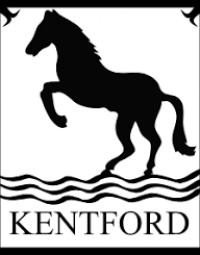

Kentford
Parish Council


Parish Council
How different would it be to today?
Certainly no speeding lorries or cars.
Inside houses, no electric or modern homely comforts. That means no WIFI kids!England in 1841 was buzzing. A new queen ( Victoria) was on the thrown, and New Zealand, Hong Kong and South Africa had just been made part of the rapidly expanding British Empire. The first photograph had just been taken and Charles Dickens was about to create his Christmas Carol.
There was, however, a darker side that Dickens noticed of growing hunger amongst the working people, caused by poor harvests and artificially high food prices, as a result of farmer –friendly Corn Laws. There were times in the 1840s when a loaf of bread cost a day’s wages. It was well described as the Hungry Forties.
Let’s take a stroll down Bury Road, Kentford not now but in 1841. Approaching from the East, take a look in the first ramshackled wooden house on your left ( no.57 on the map, somewhere near the Old Village Hall). It is rented by Stephen Howard ( aged 40) from John Wellsman, who he also works for at Bull Farm (now Kentford House). He lives there with his wife Ann ( 30) and 5 children – James (9), William (7) John ( 5) Elizabeth (3) and Robert (1) They somehow find room for Elijah and Susan Wilson to lodge with them. Elijah raises chickens and ducks ( making him a Poulterer) so he would be a big help for the growing family around him. Food didn’t come from Tescos. Their small garden was full of fruit and vegetables, and any waste food went to fatten the pig in the shed.
Emerging from the house with a thought, “How do they manage?”, your eye catches a much grander building – the ancient Tollgate House, home to the Bury to Newmarket Road Toll Collector, William Woalding (75) ( no 30, gone now, but close the Herringswell Road/ Bury road crossing). Here he has sat -day in day out -collecting money to repair the roads. Only 17% of roads in England had a toll, so expect a high quality road to travel along , ( but not A14 standard). Such is the delay this commerce creates that a traveller was often persuaded to rest at one of 2 public houses conveniently close by. Reputedly, The Cock was for Gentlefolk whilst the rougher traveller felt more at home at The Bull. At one point this double act of pubs was run by a double act of husband ( The Cock ) and wife (Bull) but that might have been a bit of a story!
`In 1841, The Cock (No.64) was owned by Farmer Wellsman,( yes him again) but run and lived in by Richard Avey (40). Alongside the many customers, the premises found space for his family of 8 Aveys as well as 2 servants. What a busy place that would be to visit. There was no school in Kentford, and it is unlikely many of the children would walk to Gazeley National School with money in hand to gain an education. Schooling for most children would have to wait until the free Kentford school opened in 1896 ( a school that eventually became the Old Village Hall)
Having had a drink at the pub, you may still be capable of spotting amongst the 35 houses that make up Kentford , a few grander than others. You admire Bull Farm, ( No..71, now Kentford House) and Chain Farm (No.73,now Meddler Stud) . John Wellsmann (60) lives at Bull Farm, a widower with 3 grown up children ( Edward (20) Sarah (23) and Marie(22)). With 2 servants, Susan(23) and Jane (17) , Wellsman is the main employer in the village, where he grows cereal crops and has fruit trees.
Walk past some imposing gates and “pleasure gardens” (No.21 now Kentford Lodge), you will be impressed by a newly built house. It is rented by an old couple of independent means, John Orbill (70) )and wife Deborah Ann (67) and tended by a servant Sophia (24).
Finally, wander down to Guildhall Pightle (No.17) next to the church and close to the river. Once upon a time here was a grand Guildhall and village land next to the church, but now it is only a field with a grand name. Our renowned John Wellsman claimed the land in 1832 under an Enclosure Act to ensure farming was efficient to feed the growing population in the cities. For old time sake, imagine the village gathering there to be photographed using the new exciting camera. The men you see are 3 farmers, 2 small holders with their pockets of land, 3 independent, old folk of means, a shopkeeper, a blacksmith called Poulter, a Poulterer called Wilson, and 25 agricultural labourers. The women include 25 housewives of the above labourers and a few ladies of means.
As these proud and curious people pose happily for the camera, the photographer would have his work cut out controlling 32 children under 12, 2 babies in arms and a gangling collection of youths who have already started working as servants or field workers.
As you walk home, would you ever imagine 175 years later the 800 plus people living in about 450 houses ( c.2 per house) that is the modern Kentford, as opposed to 149 people in 35 houses ( c.4 per house) back in 1841.
Sources
Map – sketch made by Rev Peter May of original Map 1843
Further information from Census 1841.